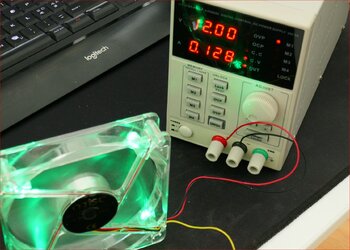- Joined
- Jan 5, 2023
Many years ago I bought this affordable Korad KA3005D linear digital power supply, for a LED scale model build, but never got around to use this power supply until now.
Ofc, wanting to just test some computer fans, things got annoying right away. Firstly I couldn't find the standard power chord for the psu, so I use the one I have for my printer. Secondly, I couldn't find any of the test leads that came with the Korad power supply, so I used the test leads that goes with my multimeter.
And it works.
What surprises me, is that, at 12 volt, if a fan is rated 0.3 ampere, it doesn't run at 0.3 ampere and 12 volts.
Testing a 40 mm Noctua fan, 12 volts and 0.04 ampere, it runs at 12 volts and 0.02 ampere.
I am no electrician, so I am more than happy just avoiding electrocuting myself here. I guess the computer fans are going at full speed here and won't spin any faster.
I ruined the wiring on that old led computer fan I had in a box, but I don't want it/need it.
In the photo below, the fan is rated 0,3 A, but runs at 0,128 A apparently. A youtuber points out that the fans use more power, more amps when the resistance is greater, like at startup.
I guess that third ground contact is for, hm extra safety.
It turned out that snipping the wires wasn't entirely necessary, as one can very carefully get the fans going using the probes (without the two tips coming into contact and shorting).
Ofc, wanting to just test some computer fans, things got annoying right away. Firstly I couldn't find the standard power chord for the psu, so I use the one I have for my printer. Secondly, I couldn't find any of the test leads that came with the Korad power supply, so I used the test leads that goes with my multimeter.
And it works.
What surprises me, is that, at 12 volt, if a fan is rated 0.3 ampere, it doesn't run at 0.3 ampere and 12 volts.
Testing a 40 mm Noctua fan, 12 volts and 0.04 ampere, it runs at 12 volts and 0.02 ampere.
I am no electrician, so I am more than happy just avoiding electrocuting myself here. I guess the computer fans are going at full speed here and won't spin any faster.
I ruined the wiring on that old led computer fan I had in a box, but I don't want it/need it.
In the photo below, the fan is rated 0,3 A, but runs at 0,128 A apparently. A youtuber points out that the fans use more power, more amps when the resistance is greater, like at startup.
I guess that third ground contact is for, hm extra safety.
It turned out that snipping the wires wasn't entirely necessary, as one can very carefully get the fans going using the probes (without the two tips coming into contact and shorting).
Attachments
Last edited:
